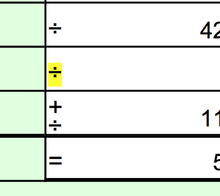Division sign
| ÷ | |
|---|---|
Division sign | |
| In Unicode | U+00F7 ÷ DIVISION SIGN (÷, ÷) |
| Different from | |
| Different from | U+2052 ⁒ COMMERCIAL MINUS SIGN U+002B + PLUS SIGN |
| Related | |
| See also | U+2236 ∶ RATIO U+003A : COLON |
The division sign (÷) is a mathematical symbol consisting of a short horizontal line with a dot above and another dot below, used in Anglophone countries to indicate the operation of division. This usage, though widespread in some countries, is not universal and the symbol has a different meaning in other countries. Its use to denote division is not recommended in the ISO 80000-2 standard for mathematical notation.[1]
In mathematics
[edit]
The obelus, a historical glyph consisting of a horizontal line with (or without) one or more dots, was first used as a symbol for division in 1659, in the algebra book Teutsche Algebra by Johann Rahn, although previous writers had used the same symbol for subtraction.[2] Some near-contemporaries believed that John Pell, who edited the book, may have been responsible for this use of the symbol.[2] Other symbols for division include the slash or solidus /, the colon :, and the fraction bar (the horizontal bar in a vertical fraction).[3][4] The ISO 80000-2 standard for mathematical notation recommends only the solidus / or "fraction bar" for division, or the "colon" : for ratios; it says that the ÷ sign "should not be used" for division.[1]
In Italy, Poland and Russia, the ÷ sign was sometimes used to denote a range of values, and in Scandinavian countries it was, and sometimes still is, used as a negation sign:[5] the Unicode Consortium has allocated a separate code point, U+2052 ⁒ COMMERCIAL MINUS SIGN for this usage uniquely;[6][7] the exact form of the symbol displayed is typeface (font) dependent.
In computer systems
[edit]Encoding
[edit]The symbol was assigned to code point 0xF7 in ISO 8859-1, as the "division sign". This encoding was transferred to Unicode as U+00F7.[8] In HTML, it can be encoded as ÷ or ÷ (at HTML level 3.2), or as ÷.
Unicode provides various division symbols:[9]
| Codepoint | Name | Symbol |
|---|---|---|
| U+00F7 | Division Sign | ÷ |
| U+27CC | Long Division | ⟌ |
| U+2215 | Division Slash | ∕ |
| U+2A38 | Circled Division Sign | ⨸ |
| U+2797 | Heavy Division Sign | ➗ |
| U+2298 | Circled Division Slash | ⊘ |
| U+22C7 | Division Times | ⋇ |
| U+29BC | Circled Anticlockwise-Rotated Division Sign | ⦼ |
See also
[edit]Notes
[edit]- ^ a b ISO 80000-2, Section 9 "Operations", 2-9.6
- ^ a b Cajori, Florian (1928). A history of mathematical notations. Vol. 1. Notations in Elementary Mathematics. The Open Court Company. pp. 242, 270–271. pp 270,271
- ^ Weisstein, Eric W. "Division". mathworld.wolfram.com. Retrieved 2020-08-26.
- ^ "Division". www.mathsisfun.com. Retrieved 2020-08-26.
- ^ "6. Writing Systems and Punctuation" (PDF). The Unicode® Standard: Version 10.0 – Core Specification. Unicode Consortium. June 2017. p. 280, Obelus.
- ^ Leif Halvard Silli. "Too narrowly defined: DIVISION SIGN & COLON". Unicode.org.
- ^ Leif Halvard Silli. "Commercial minus as italic variant of division sign in German and Scandinavian context". Unicode.org.
- ^ Korpela, Jukka (2006), Unicode Explained: Internationalize documents, programs, and web sites, O'Reilly Media, Inc., p. 397, ISBN 9780596101213
- ^ "Division symbol".
External links
[edit]- Jeff Miller: Earliest Uses of Various Mathematical Symbols
- Michael Quinion: Where our arithmetic symbols come from
![]() The dictionary definition of division sign at Wiktionary
The dictionary definition of division sign at Wiktionary
